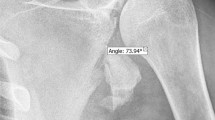Abstract
A scapular neck fracture is considered unstable if it is associated with an ipsilateral clavicular fracture or an acromioclavicular (AC) joint dislocation. Currently, it is recommended that stabilization of a disrupted shoulder girdle must be achieved through open reduction and internal fixation of the clavicular fracture or by reduction of the AC joint, without addressing the scapular neck. However, if the displaced glenoid neck is not simultaneously reduced, malalignment of the glenoid neck may persist. The purpose of this retrospective study was to analyze the effect of associated shoulder girdle injury on glenoid displacement and the influence of glenoid malalignment on clinical outcome. Nineteen patients with scapular neck fractures were reviewed clinically and radiologically at a mean of 8 years (range 2–21 years) after injury. None of them has developed nonunion of the scapular neck, and only one showed radiological signs of mild degenerative joint disease. The glenopolar angle (GPA), which assesses the rotational malalignment of the glenoid about an anteroposterior axis perpendicular to the scapular plane on plain X-rays was measured less than 20° in six patients. Three of them had sustained an associated clavicular fracture or AC joint dislocation. The other 3 patients had permanent severe malalignment of the glenoid neck in the absence of an associated shoulder girdle injury. Five patients with GPA less than 20° complained of moderate or severe pain, whereas of the 13 patients with mild or no glenoid rotational displacement or medial displacement alone, 11 patients had no or mild pain, and only 2 had moderate or severe pain (P = 0.0095). Five patients presented with reduced activities of daily living, 4 of them had severe glenoid rotational displacement (P = 0.0173). Loss of motion was found in only 2 patients, and both had a severely displaced glenoid neck (P = 0.088). In conclusion, severe displacement of the glenoid neck may occur with or without associated fracture of the clavicle or dislocation of the AC joint and can be identified as a GPA less than 20°. Scapular neck fractures with such malalignment have a less favorable long-term outcome compared with otherwise comparable cases with absence of glenoid malalignment as measured with the glenopolar angle.
Similar content being viewed by others
Author information
Authors and Affiliations
Additional information
Received: 16 February 2000
Rights and permissions
About this article
Cite this article
Romero, J., Schai, P. & Imhoff, A. Scapular neck fracture – the influence of permanent malalignment of the glenoid neck on clinical outcome. Arch Orth Traum Surg 121, 313–316 (2001). https://doi.org/10.1007/s004020000224
Issue Date:
DOI: https://doi.org/10.1007/s004020000224




